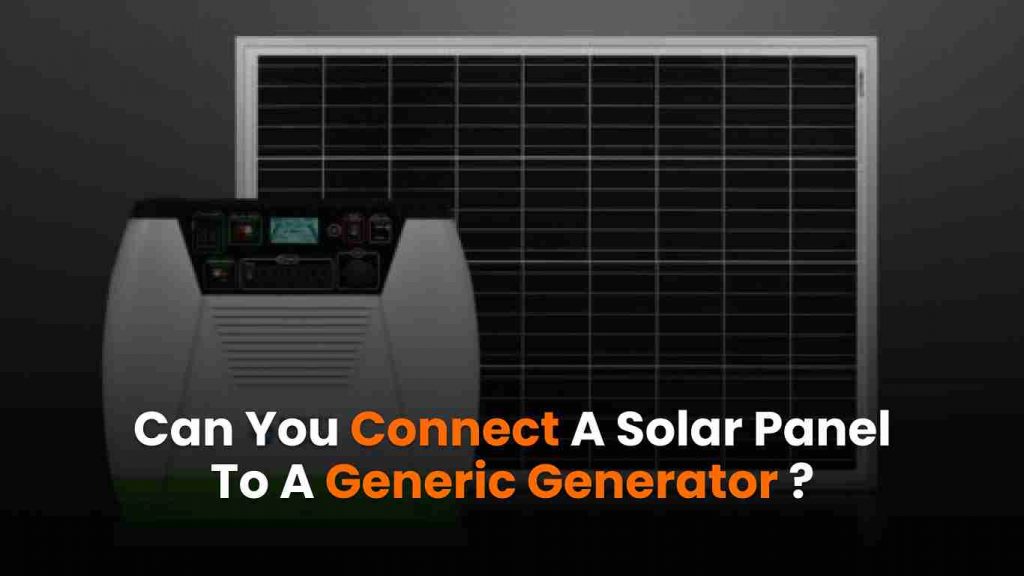If you’ve ever wondered whether you can connect a solar panel to a generic generator, you’re not alone. Traditional fuel-powered generators and solar power systems operate differently, so making them work together requires careful planning. In this guide, we’ll explore the possibilities, challenges, and best practices for using solar panels with a generic generator, along with some tips to optimize your setup.
Understanding the difference: Solar generators vs. generic generators
Before diving into connections, let’s clarify the distinction between solar and generic generators.
- Solar generator: A self-contained system that includes a battery, charge controller, inverter, and solar panels. These generators store solar energy and provide silent, emission-free power.
- Generic generator: Usually a gas, diesel, or propane-powered unit that generates electricity through combustion. It provides immediate power but relies on fuel and produces noise and emissions.
Since solar panels generate DC electricity and traditional generators output AC electricity, connecting them directly is not straightforward. However, there are ways to integrate solar panels into a system that includes a generic generator.
Can you directly connect a solar panel to a generic generator?
In short, no, you cannot directly connect a solar panel to a generic fuel-powered generator. Solar panels generate direct current (DC) electricity, whereas standard generators produce alternating current (AC). Moreover, fuel-powered generators do not have the necessary charge controllers to regulate power from solar panels.
However, you can integrate solar panels into a system that includes a generic generator by using one of the following methods:
1. Using a battery bank and inverter
One of the best ways to combine solar panels and a generator is through a battery bank with an inverter. Here’s how it works:
- The solar panel charges a battery bank using a charge controller to regulate voltage and prevent overcharging.
- The stored energy in the battery is converted into AC power using an inverter.
- If needed, a generic generator can recharge the battery bank when solar power is insufficient.
2. Using a solar charge controller with a hybrid generator
Some generators are designed to work with solar power as hybrid systems. These models include built-in charge controllers and inverters, allowing them to accept input from both solar panels and fuel sources. If you have a hybrid generator, check its specifications to determine compatibility with solar panels.
3. Using a transfer switch for backup power
If you want a backup power solution, you can set up a transfer switch to switch between a solar power system and a generator.
- When there’s enough sunlight, the solar panel system powers your appliances.
- When solar energy is low (e.g., at night or during cloudy weather), the transfer switch activates the generator to provide power.
This setup ensures continuous electricity without the need for manual switching.
Important considerations for connecting solar panels to a generator
1. Voltage and Compatibility
Each power source has specific voltage requirements. Solar panels, charge controllers, inverters, and generators must be compatible to avoid damage. Always check:
- Solar panel output voltage (Vmp, Voc)
- Battery voltage (12V, 24V, or 48V systems)
- Generator AC output voltage (120V, 240V)
Mixing incompatible voltages can result in equipment failure or inefficiencies.
2. Power load and Capacity
- Determine your total power needs before choosing components.
- Ensure your battery bank and inverter can handle your daily watt-hour consumption.
- Check if your generator provides sufficient power for both immediate use and battery recharging.
3. Safety precautions
- Never connect a solar panel directly to a fuel generator.
- Use a charge controller to regulate voltage and prevent battery overcharging.
- If using an inverter, ensure it matches the generator’s wattage capacity to prevent overloads.
- If unsure, consult an electrician or solar expert before setting up your system.
Recommended equipment for a hybrid solar-generator setup
If you’re looking to integrate solar panels with a generator, here are some key components to consider:
- Solar Panels – Choose panels with appropriate wattage (e.g., 100W to 400W).
- Charge Controller – Regulates voltage from solar panels (PWM or MPPT models available).
- Battery Bank – Stores energy for later use (lithium-ion or deep-cycle lead-acid recommended).
- Inverter – Converts DC to AC for running household appliances.
- Transfer Switch – Automates switching between solar and generator power.
- Generator – Backup power source for low-sunlight conditions (gas, diesel, or propane).
Conclusion: Finding the right solar-generator solution
While you cannot directly connect a solar panel to a generic fuel-powered generator, there are effective ways to integrate both into a reliable power system. Whether through a battery bank, hybrid generator, or transfer switch, you can create a setup that takes advantage of solar energy while keeping a fuel generator as a backup. By understanding voltage compatibility, safety precautions, and the right equipment, you can ensure an efficient and seamless power solution for your needs.
Would you like recommendations for specific solar panels and generators? Let us know, and we can help you choose the best combination for your setup!

